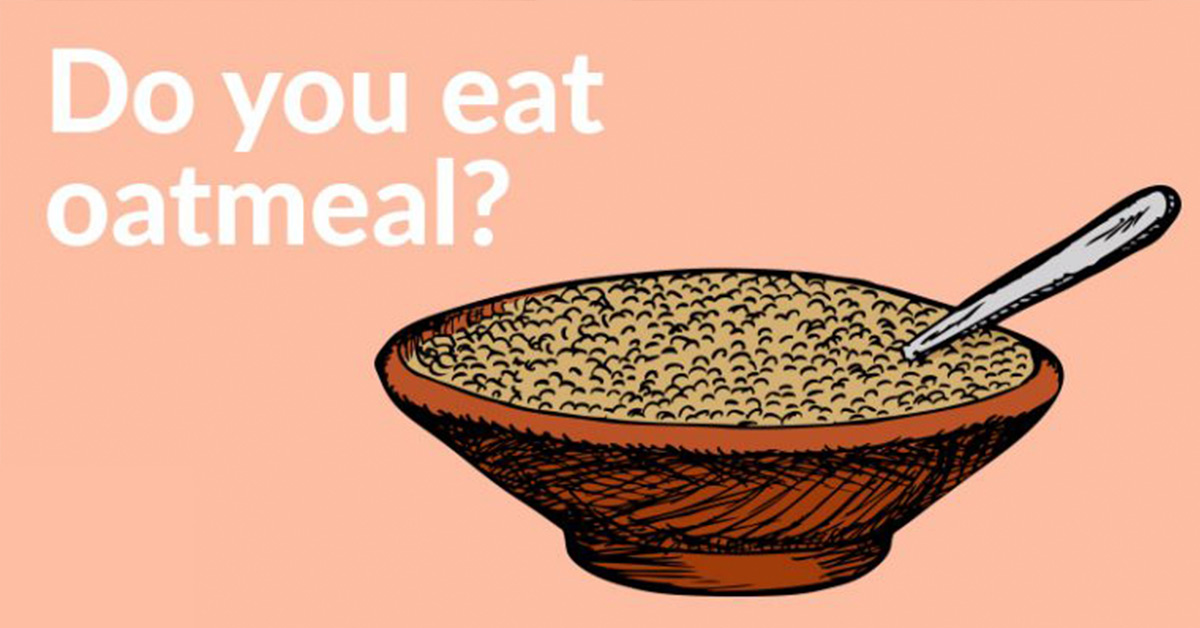It’s an unfortunate reality, but most people will probably tell you that they start their day with a big bowl of cereal (if they even eat breakfast at all). Sure, there are some healthy cereals out there but most of them are high in hidden sugar, refined carbohydrates, artificial colors, and preservatives. That being said, if you’re a cereal lover and crave the feeling of eating out of a bowl in the morning, a healthy swap to transition to is oatmeal.
Why You Need To Be Eating More Oatmeal
Let’s take a look at what makes oatmeal so good for us, and why we should be eating it for breakfast [1].
One portion (30g) of raw oats contains 117 calories, and by weight, contains 66% carbohydrates, 17% protein, 7% fat, and 11% fiber. Oats are also an excellent source of vitamins, minerals and antioxidants. In fact, whole oats are the only source of a unique group of antioxidants called avenanthramides, believed to have protective effects against heart disease.
Health Benefits of Oatmeal

So we know oatmeal is good for you, with a good amount of fiber, protein, carbs but what do all of these things do for us?
Carbohydrates
Like we said, oats are 66% carbohydrate, which may seem like a lot, but these are good carbs which have their fibre intact and therefore release much slower into the bloodstream. 11% of the carbohydrates are fiber and 85% are starch. The starch in oats is different than the starch in other grains. It has a higher fat content, and a higher viscosity, which is its ability to bind with water [1].
There are 3 types of starch in oats:
- Rapidly digested starch (7%) which is broken quickly and turned into glucose
- Slowly digested starch (22%) is broken down and absorbed more slowly
- Resistant starch (25%) acts like a type of fiber; it doesn’t get digested like the other starch but improves gut health by feeding good gut bacteria
Fiber
Oats contain both soluble and insoluble fiber, but mostly it contains the soluble fiber beta-glucan. Beta-glucan is the fiber that makes oatmeal so gelatinous, but it is also packed with health benefits. Beta-glucans are known to lower cholesterol levels and increase excretion of bile acids. They are also believed to cause a reduction in blood sugar and insulin levels after a carbohydrate-rich meal.
Daily consumption of beta-glucans has also been shown to lower cholesterol, especially LDL, the “bad” cholesterol, and may therefore decrease the risk of heart disease [1].
The soluble fiber in oats also leads to slower digestion, increased satiety, and suppressed appetite, making you feel fuller for longer.
Protein
Oats are a source of quality protein, with dry oats containing around 11-17% protein. The main protein in oats is called avenalin (80% protein), which isn’t found in any other grain but is similar to the protein in legumes. It also contains a minor protein called avenin, which is similar gluten in wheat. However, whole oats are safe for most people with gluten intolerance or sensitivity. Protein helps not only in building and maintaining muscle, but helps keep our bodies satiated which is important when trying to lose weight.
Fat
Whole oats contain more fat than most other grains, ranging from 5-9%. It consists mostly of unsaturated fatty acids.
Oatmeal Dos and Don’ts
While oatmeal is a great source of fiber, carbs, and protein, there are some mistakes that many people make when it comes to buying and eating oatmeal.
Don’t
- Buy processed or instant oatmeal: Boxed oatmeal is filled with added sugars and artificial flavorings that negate any of the health benefits oatmeal has in the first place [2]. Plus, processed instant oats will also spike blood sugar levels much faster than regular, rolled oats.
Do
- Buy rolled, or steel cut oats: you can reap all the benefits of oatmeal without the added sugar, and ensure a more steady release of glucose into the bloodstream.
Don’t
- Think you can eat as much as you want: while oatmeal is good for you, portion control is key as it is still high in carbohydrates.
Do
- Eat it: eat smaller portions while still staying full; aim for a serving size of ½ cup dry or less.
Don’t
- Add sugary toppings: avoid adding in handfuls of raisins, dried cranberries and drizzling on far too much maple syrup. It’s an easy trap to fall into that can easily bump up the sugar content.
Do
- Add nutrient-dense toppings: Plain oatmeal can be hard to swallow on its own. Feel free to add toppings but don’t go overboard. Great additions are nuts, seeds, nut butters, fresh fruit, dried coconut, limited amounts of natural sweeteners like maple syrup or honey. Bonus: consider mixing in organic protein powder to increase the protein content of your oatmeal.
And finally…
- Read the label: if you’re celiac or sensitive to gluten, check the packaging to ensure that they are processed in gluten-free facility; this information should be easy to find on the package.
How To Enjoy Your Oats
There are almost countless ways to enjoy oats, there isn’t one end-all be-all way to make and eat them. Here are some great recipes you can try, experiment with, and change to find your own favorite way to eat them.
- Strawberry Cheesecake Oats
- Peanut Butter Overnight Oats
- Blueberry Almond Oats
- Berry Overnight Oats
There you have it, everything you ever needed to know about oats and oatmeal. Now go oat there and get yourself a bowl of oatmeal!
Sources
- “Oats 101: Nutrition Facts and Health Benefits.” Healthline. Adda Bjarnadottir, MS, RDN (Ice). May 17, 2019.
- “Oatmeal and Diabetes: The Do’s and Don’ts.” Healthline. Ana Gotter. February 7, 2020

